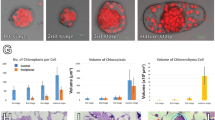Summary
The behavior of nucleoids during the leucoplast division cycle in the epidermis of onion (Allium cepa) bulbs was investigated using DNA-specific fluorochrome 4'6-diamidino-2-phenylindole (DAPI) staining. The leucoplast was morphologically amoeboid and continuously changed its shape. A dumbbell-shaped leucoplast divided into two spherical daughter ones by constriction in the middle region of the body. Leucoplasts contained 4–10 mostly spherical, oval, partly rodand dumbbell-shaped nucleoids which were dispersed within the bodies. The proportion of one DNA molecule of a T4 phage particle to the small leucoplast nucleoid in the grain density of negative film was 1 to 0.91. Comparison of the present result and another groups' biochemical results suggested that a small leucoplast nucleoid contains one DNA molecule. The dumbbell-shaped leucoplast probably before division contained about twice as many nucleoids as the spherical leucoplast after division, and each half of the dumbbell contained about half the number of nucleoids. Nucleoids increased in number with growth of the leucoplast. The behavior of nucleoids during the leucoplast division cycle in onion bulbs was basically similar to that during the chloroplast division cycle in higher plants and green algae, which was previously reported (Kuroiwa et al. 1981 b).
Similar content being viewed by others
References
Bereiter-Hahn, J., 1976: Dimetylaminostyrylmetylpyridiniumiodine (DASPMI) as a fluorescent for mitochondriain situ. Biochim. biophys. Acta423, 1–14.
Chaly, N., Possingham, J. V., Thompson, W. W., 1980: Chloroplast division in spinach leaves examined by scanning electron microscopy and freeze-etching. J. Cell Sci.46, 87–96.
Coleman, A. W., 1978: Visualization of chloroplast DNA with two fluorochromes. Exp. Cell Res.114, 95–100.
—, 1979: Use of the fluorochrome 4'6-diamidino-2-phenyl-indole in genetic and developmental studies of chloroplast DNA. J. Cell Biol.82, 299–305.
Coleman, A. W., Heywood, P., 1981: Structure of the chloroplast and its DNA in Chloromonadophycean algae. J. Cell Sci.49, 401–409.
Fasse-Franzisket, U., 1955: Die Teilung der Proplastiden und Chloroplasten beiAgapanthus umbellatus l'Herit. Protoplasma45, 194–227.
Freifelder, D., 1970: Molecular weights of coliphages and coliphage DNA. IV. Molecular weights of DNA from bacteriophages T4, T5 and T7 and the general problem of determination ofM. J. mol. Biol.54, 567–577.
Green, P. B., 1964: Cinematic observations on the growth and division of chloroplasts inNitella. Amer. J. Bot.51, 334–342.
Hajduk, S. L., 1976: Demonstration of kinetoplast DNA in dyskinetoplastic strains ofTrypanosoma equiperdum. Science191, 858–859.
James, T. W., Jope, C., 1978: Visualization by fluorescence of chloroplast DNA in higher plants by means of the DNA-specific probe 4'6-diamidino-2-phenylindole. J. Cell Biol.79, 623–630.
Kapuściński, J., Skoczlas, B., 1977: Simple and rapid fluorimetric method for DNA microassay. Anal. Biochem.83, 252–257.
Kapuściński, J., Szer, W., 1979: Interactions of 4'6-diamidine-2-phenylindole with synthetic polynucleotides. Nucleic Acids Res.6, 3519–3534.
Kolodoner, R., Tewari, K. K., 1972: Molecular size and conformation of chloroplast deoxyribonucleic acid from pea leaves. J. biol. Chem.247, 6355–6364.
Kuroiwa, T., Suzuki, T., 1980: An improved method for the demonstration of thein situ chloroplast nuclei in higher plants. Cell Struct. Func.5, 195–197.
Kuroiwa, T., Nishibayashi, S., Kawano, S., Suzuki, T., 1981 a: Visualization of DNA in various phages (T4,χ, T7,ϕ 29) by ethidium bromide epi-fluorescent microscopy. Experientia37, 969–970.
Kuroiwa, T., Suzuki, T., Ogawa, K., Kawano, S., 1981 b: Chloroplast nucleus — General occurrence, number, size, shape and a model for amplification of chloroplast genome during chloroplast development. Plant Cell Physiol.22, 381–396.
Lüttke, A., 1981: Heterogeneity of chloroplasts inAcetabularia mediterranea. Heterogeneous distribution and morphology of chloroplast DNA. Exp. Cell Res.131, 483–488.
Manning, J. E., Richards, O. C., 1972: Isolation and molecular weight of circular chloroplast DNA fromEuglena gracilis. Biochim. biophys. Acta259, 285–296.
Manning, J. E., Wolstenholme, D. R., Richards, O. C., 1972: Circular DNA molecules associated with chloroplasts of spinach,Spinacia oleracea. J. Cell Biol.53, 591–601.
Possingham, J. V., Saurer, W., 1969: Changes in chloroplast number per cell during leaf development in spinach. Planta86, 186–194.
Russell, W. C., Newman, C., Williamson, D. H., 1975: A simple cytochemical technique for demonstration of DNA in cells infected with mycoplasmas and viruses. Nature253, 461–462.
Senser, F., Schotz, F., 1964: Untersuchungen über die Chloroplastenentwicklung beiOenothera. II. Der Albivelutinatyp. Planta62, 171–190.
Sprey, B., 1968: Zum Verhalten DNS-haltiger Areale des Plastidenstromas bei der Plastidenteilung. Planta78, 115–133.
Schildkraut, C. L., Marmur, J., Doty, P., 1962: Determination of the base composition of deoxyribonucleic acid from its buoyant density in CsCl. J. mol. Biol.4, 430–443.
Wells, R., Ingle, J., 1970: The constancy of the buoyant density of chloroplast and mitochondrial deoxyribonucleic acids in a range of higher plants. Plant Physiol.46, 178–179.
Whatley, J. M., 1974: Chloroplast development in primary leaves ofPhaseolus vulgaris. New Phytol.73, 1097–1110.
Williamson, D. H., Fennell, D. J., 1975: The use of fluorescent DNA-binding agent for detecting and separating yeast mitochondrial DNA. In: Methods in Cell Biol. (Prescott, D. M., ed.), Vol. 12, pp. 335–351. New York: Academic Press.
Author information
Authors and Affiliations
Rights and permissions
About this article
Cite this article
Nishibayashi, S., Kuroiwa, T. Behavior of leucoplast nucleoids in the epidermal cell of onion (Allium cepa) bulb. Protoplasma 110, 177–184 (1982). https://doi.org/10.1007/BF01283320
Received:
Accepted:
Issue Date:
DOI: https://doi.org/10.1007/BF01283320




